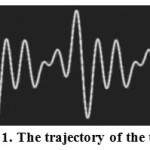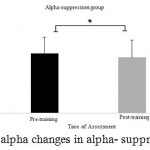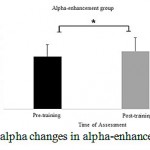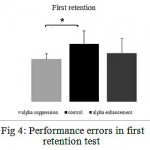How to Cite | Publication History | PlumX Article Matrix
The Effect of Alpha Neurofeedback Training on Motor Skill Acquisition
Mohammadreza Ghasemian1, Hammidreza Taheri1, Alireza Saberi Kakhki1 and Majid Ghoshuni2
1Ferdowsi University of Mashhad, Mashhad-Iran.
2Department of Biomedical Engineering, Mashhad Branch, Islamic Azad University, Mashhad, Iran.
*Corresponding Author E-mail: Hamidtaheri@um.ac.ir
DOI : http://dx.doi.org/10.13005/bbra/2313
ABSTRACT: The present study aimed to compare the effects of two types of neurofeedbackprotocols (alpha enhancement& alpha suppression) on the motor skill acquisition. 42 volunteersparticipated in the present study. The subjects were divided into three groups of ‘alpha enhancement’, ‘alpha suppression’ and ‘control’. In the alpha suppression group, the objective was to reduce alpha brain waves and in the alpha enhancement group, the objective was to increase the alpha amplitude over the motor cortex areas before the motor intervention. During the acquisition stage, the participants practiced the pursuit tracking task. In order to evaluate the effectiveness of interventions on motor learning, the participants were assessed at intervals of 90 minutes, 24 hours and one week after the interventions. The results showed that all of the groups were progressing during the interventions; however, participants in the alpha suppression group had a better performance in first retention test. The superiority of participants in the alpha suppression group was not maintained in subsequent evaluations. Based on the results, reduction of alpha range and its subsequent increased motor cortex excitability can provide beneficial effects in the acquisition of a new motor skill. However, more studies are needed to confirm the sustainability of these effects over time.
KEYWORDS: Neurofeedback; Cortical excitability; Motor skill acquisition
Download this article as:| Copy the following to cite this article: Ghasemian M, Taheri H, KakhkiA. S, Ghoshuni M. The Effect of Alpha Neurofeedback Training on Motor Skill Acquisition. Biosci Biotech Res Asia 2016;13(3). |
| Copy the following to cite this URL: Ghasemian M, Taheri H, KakhkiA. S, Ghoshuni M. The Effect of Alpha Neurofeedback Training on Motor Skill Acquisition. Biosci Biotech Res Asia 2016;13(3). Available from: https://www.biotech-asia.org/?p=15472 |
Introduction
In recent years, the effectiveness of neuro feedback (NF) has been examined in numerous medical and non-medical contexts including memory improvement, mood enhancement, addiction recovery and even error reduction among pilots. NF is a process through which people learn to control their brain waves via connecting their brain waves to received feedback(1, 2).The underlying explanation for the use of NF is based on some certain correlations between patterns of brain waves and some neurological and behavioral functions. Thus, people can achieve optimum brain function when some brain waves are activated(3). In the field of motor performance NF is used in areas such as rehabilitation of patients with movement disorders or improvement of surgeons’ fine motor skills in surgical procedures(2). It has been shown that the dominance of a particular brain frequency band before training sessions may be associated with the acquisition of motor skills (4). One of the most important brain rhythms in this context is the alpha wave with a frequency of 8 to 12 hertz. In the classical view, this rhythm is usually associated with reduced anxiety levels, improved moods and relaxed states; but, from the cognitive perspective, the alpha wave is considered as an’idling’ rhythm to get things done(5). In an alternative model, the alpha wave acts as a ‘top-down’ pattern reducing the activities of unnecessary processes in the brain. In this model, the alpha wave increases the ratio of signal to noise (an important ratio in the perception of stimuli) and improves processing efficiency (6). Based on the Neural Efficiency Hypothesis, higher levels of alpha may help people reduce unnecessary brain activities and focus on a certain task more easily(7).Although, many studies have supported the role of alpha enhancement in improving performance; however, results of some studies have shown that alpha suppression in the motor cortex area immediately before training increases the rate of acquisition (4). The underlying explanation for this improvement is related to motor cortex excitability. In fact, studies have shown a relationship between motor skill acquisition and motor cortex excitability. For example, Nitsche and colleagues (2003) and Boyd and colleagues (2009) indicated that increasing premotor cortex excitability leads to an increase in motor memory consolidation(8, 9). Rose and colleagues (2010) showed that alpha suppression, done through NF, can increase motor cortex excitability(9). Considering the relationships between changes in brain waves and cortical excitability and between cortical excitability and motor skill acquisition, Rose and colleagues (2014) showed that alpha suppression in the motor cortex area immediately before practicing a motor skill increases the rate of acquisition. It must be noted that, these researchers examined only one experimental group and did no follow-up assessment(4). Accordingly, considering the existence of significant relationships between alpha waves and motor performance and the availability of evidences supporting the roles of both NF protocols of alpha enhancement and alpha suppression in improving motor performance, comparing the effectiveness of those protocols seems quite necessary. In previous studies, motor performance was only emphasized during the acquisition stage and the sustainability of interventions over time was ignored. Therefore, the present study was conducted to compare the effectiveness of alpha suppression and alpha increase NF protocols in motor memory consolidation and their sustainability over time.
Material and Methods
Materials
Forty-two volunteers aged 18 to 22 years old (M age = 19.94, SD = 0.96), right-handed with no history of disease and medication, and reported more than 6h of regular sleep per night before and during the experiment days. The participants were screened by a self-report questionnaire and Informed consents were obtained from all participants. Then, they were randomly placed in three groups of neuro feedback.
The task used in this study was a modified mode of pursuit tracking task adopted previously by Hill and Raab (2005) from Wulf and Schmidt (1975) (10). The participants were set at a 17-inch monitor where a red circle with a diameter of 10 pixels moved in a predetermined direction. The participants were supposed to pursue the moving stimulant through a circular white marker with the same size. The white marker was handled by individuals via a computer mouse and the left hand, i.e. non-dominant hand. The reason for choosing the left hand was because people seldom use the hand, and previous research has indicated that improvement is greater in the non-dominant hemisphere as a result of cortical stimulation (11). The movement path of the stimulant was controlled by a series of sine and cosine motion derived from the following formula adopted from Wulf and Schmidt (1997) (10):
f(x) = b0 + a1 sin(x) + b1 cos(x) + a2 sin(2x) + b2 cos(2x) +….+ a5 sin(5x) + b5 cos(5x).
The values (a1…a5, b0…b5) ranged randomly from -5 to 5 (10). The task was programmed through MATLAB and presented through C-sharp application (C♯). The performance accuracy was calculated through root mean square error (RMSE).
Experiment
At first, the demographic backgrounds and health records of each subject were collected through a self-report questionnaire. Then, the subjects were randomly divided into three groups: control, “alpha enhancement” and “alpha suppression”. The brain rhythm between 8 and 12 Hz rhythm was suppressed in the “alpha suppression” group and increased in the “alpha enhancement” group for 30 minutes at C4 and then the participants immediately began to practice the motor task. This frequency was selected because of the relationship between the alpha and cortical excitability. Moreover, C4 was chosen because of the use of non-dominant or left hand. In the control group, the motor task training and the time spent in the laboratory were similar to the other groups, but the subjects did not participate in the neurofeedback sessions. Unlike the common plan in the field of neurofeedback, this study did not adopt a sham group. Since some studies have shown that using this method leads to a similar state of helplessness and frustration where the subjects experience no sense of achievement and learning and cannot establish a relationship between feedback and their status, it gives rise artificially to drop in motivation and performance degradation(12).
The motor task training in all groups lasted for 20 minutes, as previous research had shown that changes in the excitability of the motor cortex were an outcome of neurofeedback training within an almost identical period(9).
After the first stage, the subjects participated in retention tests of the task within 90 minutes, 24 hours, and one week after the training session. To evaluate the effectiveness of neurofeedback sessions in altering the brain waves, the variations in EEG were first qualitatively assessed in time intervals so as to determine the ascending or descending patterns of target frequency changes in brain waves. Then, the changes in each frequency in times before and after neurofeedback sessions were compared by paired sample t-test. In addition, the effects of performance variations during the acquisition phase were examined through the Repeated Measures ANOVA. Moreover, the motor performances between the groups were compared through one way ANOVA for each test.
Neuro feedback
EEG signals were recorded using Flex Comp device, developed by Thought Technology (TT), and visual NFB training was carried out with the accompanying and Bio graph software. The EEG used for feedback was sampled at 256 Hz at C4. The scalp area was carefully scrubbed with Nuprepgel, followed by application of Ten20 electrode paste. A ground electrode placed on the left ear and right ear was used as the reference electrode. Reward thresholds were set to be 70% of the time below the initial 8-12 Hz mean amplitude (baseline). With respect to the neuro feedback training strategy, subjects were given no explicit verbal instructions and were told to be guided by the feedback process instead. Moreover, when the participant had an eye-movement or other muscle activity which caused EEG fluctuations, the feedback was suspended according to artifact rejection thresholds.
EEG Recording and Analysis
Impedances were kept below 5kΩ in different electrodes in all trials. The acquired signal was amplified and filtered with an analog elliptic band pass filter ranging from 0.1 to 64 Hz. Furthermore, a 50Hz notch filter was enabled. Sampling frequency was 256 Hz, and A to D precision was 14 bit (13). EEG signals containing greater activity than 50 µV due to obvious artifacts (e.g., movements and eye blinks) were eliminated. The power spectrum density of EEG signals was approximated by Welch’s averaged modified periodogram with 2-sec epochs (0.5-Hz frequency resolution), 50% overlap, and a Hanning window (14).
Results
Neuro Feedback Intervention
Figure1 illustrates the alpha range changes before and after neurofeedback training session. The results of paired sample t-test indicated a significant increase in the alpha in “alpha-enhancement” group (t=2.53, P=0.025), while in the “alpha-suppression” group this frequency band declined significantly (t=-3.57, P=0.003).
 |
Figure 1. The trajectory of the task |
Motor Performance
In order to ensure the data normality, the Shapiro-Wilk test was employed for all variables and groups. Generally, the results indicated no statistically significant difference in the variables (P<0.05). Accordingly, it can be concluded that the data is normal, and the parametric tests can be used. In order to ensure that there is no difference between individuals’ performances, the first block of training was examined through one-way analysis of variance. The results showed that there was no significant difference between the groups (F2, 39=0.63, P=0.52, Eta2=0.03). To examine the progress rate of individuals in every test, the two-way ANOVA was used, showing a significant main effect of training (F3.15, 122.84=22.13, P=0.0001, Eta2=0.36); however, the follow-up test results revealed that the root mean square error significantly decreases, i.e. a significant difference between the first block and all the training blocks (P>0.05). Nevertheless, the main effect of the groups was not significant (F2, 39=0.9, P=0.42, Eta2=0.04), i.e. there was no statistically significant interaction between the group and test procedures (F6.3, 122.84=1.59, P=0.16, Eta2=0.07). To compare the performance of groups in retention tests, one-way ANOVA was used. The only significant difference was observed between groups on the first retention test (F2, 39=4.91, P=0.013, Eta2=0.2).The Bonferroni post hoc test indicated a difference between the pre-training groups and control (P<0.001). In tests after 24 hours (F2, 39=0.88, P=0.42, Eta2=0.04) and one week later (F2, 39=1.58, P=0.21, Eta2=0.07), however, the superior performance of pre-training group was not statistically significant as in the first retention test.
 |
Figure 2: Alpha changes in alpha- suppression
|
 |
Figure 3: alpha changes in alpha-enhancement
|
Discussion
The present study aimed to compare the effects of two types of NF protocols (alpha enhancement& suppression) on the motor memory consolidation. The alpha wave was used due to the existence of relationships between motor cortex excitability and alpha and between cortical excitability and motor skill acquisition. C4 region was also used due to the involvement of left hand in the acquisition of motor skills. In general, results of evaluating alpha frequency bands before and after practicing indicated the effectiveness of these training protocols in both alpha enhancement and suppression. Accordingly, subsequent effects of these protocols on motor performance were examined at intervals of 90 minutes, 24 hours and one week after the interventions. Based on the results, the performance of all participants improved during the acquisition stage and their performance errors significantly decreased. Thus, motor skills training improved the performance of all participants. During the training period (or the acquisition stage), no difference was observed in motor performance of the participants; however, 90 minutes after the training, participants in the alpha suppression group outperformed others. As noted, participants in the alpha suppression group suppressed alpha frequency in the motor cortex area before starting to practice motor skills.In this regard, Rose and colleagues (2010) showed that cortical excitability increases in motor cortex area by suppressing alpha rhythm(9). The improvement of motor skill acquisition as a result of alpha suppression was in line with the results of Nitsche et al (2003), Boyd et al (2009) and Rose et al (2014) that showed the increase of motor cortex excitability leads to better motor skill acquisition(4, 8). According to these studies, increased excitability can improve acquisition in two ways:firstthrough an online or simultaneous effect occurring during the training session; and second through the offline effect or changes occurring after the training session. Various studies have shown that increased excitability strengthens synoptic connections(15). Some studies have indicated that improved performance resulting from increased excitability occurs through mechanisms similar to Long-Term Potentiation(16). Furthermore, studies on animal subjects have indicated that increased cortical excitability during the training session makes changes in the synthesis of proteins that directly affect learning(17). Pharmacological studies have also indicated that learning can be improved by medications increasing the level of cortical excitability(18). The superiority of the alpha suppression group in the retention stage of this study could be due to the positive effects of excitability on offline learning. As noted, that superiority did not continue in subsequent evaluations. This finding was in line with results of a study conducted by Reyes and colleagues (2009). They reported that increased motor cortex excitability improved learning ability of people during the training sessions; but, no significant difference in long-term retention was observed between participants in the rate of forgetting(19). Among the factors affecting long-term retention of a skill, type of task and the number of training sessions can be mentioned. The used task was continuous; thus, it seems that discrete and continuous tasks are different in warm-up decrement. Since the duration of continuous tasks are longer, the initial performance drop might be compensated by the middle and final performances. Thus, memory differences between the groups may become neutralized this way (20). Using a one-session training program could be another reason for the lack of sustainability in this study. Therefore, it is recommended to conduct similar studies based on multiple-session training programs.
 |
Figure 4: Performance errors in first retention test
|
Conclusions
The results of this study indicated that alpha suppression may be more effective in the consolidation of motor memory. However, as indicated, this effect is not sustainable. It was also shown that alpha suppression and subsequent increase in motor cortex excitability can have positive effects on the acquisition of a new motor skill. Therefore, the NF protocol of alpha suppression can be used as a non-invasive and relatively accessible technique to increase motor cortex excitability level and improve the acquisition of daily motor skills, especially for patients with movement disorders. On the other hand, since most studies adopt learning of a new motor skill, it is recommended that future researches explore the impact of these NF protocols on re-acquisition of previously learned skills used in rehabilitation field It is also recommended to conduct similar studies based on long-term and multiple-session training programs.
Compliance with Ethical Standards
Funding
This study was funded by Ferdowsi University of Mashhad
Conflict of Interest
The authors declared that there is no conflict of interest.
Ethical approval
All procedures performed in studies involving human participants were in accordance with the ethical standards of the Ferdowsi university of Mashhad research committee and with the 1964 Helsinki declaration and its later amendments or comparable ethical standards.
Informed consent
Informed consent was obtained from all individual participants included in the study.
References
- Raymond J, Varney C, Parkinson LA, Gruzelier JH. The effects of alpha/theta neuro feedback on personality and mood. Cognitive brain research. 2005;23(2):287-92.
CrossRef - Ros T, Moseley MJ, Bloom PA, Benjamin L, Parkinson LA, Gruzelier JH. Optimizing microsurgical skills with EEG neurofeedback. BMC neuroscience. 2009;10(1):1.
CrossRef - Gruzelier JH. EEG-neurofeedback for optimising performance. I: a review of cognitive and affective outcome in healthy participants. Neurosci Biobehav Rev. 2014;44:124-41.
CrossRef - Ros T, Munneke M, Parkinson L, Gruzelier J. Neurofeedback facilitation of implicit motor learning. Biol Psychol. 2014;95:54-8.
CrossRef - Vernon D, Dempster T, Bazanova O, Rutterford N, Pasqualini M, Andersen S. Alpha neurofeedback training for performance enhancement: reviewing the methodology. Journal of neurotherapy. 2009;13(4):214-27.
CrossRef - Von Stein A, Sarnthein J. Different frequencies for different scales of cortical integration: from local gamma to long range alpha/theta synchronization. Int J Psychophysiol. 2000;38(3):301-13.
CrossRef - Cooper NR, Croft RJ, Dominey SJ, Burgess AP, Gruzelier JH. Paradox lost? Exploring the role of alpha oscillations during externally vs. internally directed attention and the implications for idling and inhibition hypotheses. Int J Psychophysiol. 2003;47(1):65-74.
CrossRef - Boyd LA, Linsdell MA. Excitatory repetitive transcranial magnetic stimulation to left dorsal premotor cortex enhances motor consolidation of new skills. BMC neuroscience. 2009;10(1):72.
CrossRef - Ros T, Munneke MA, Ruge D, Gruzelier JH, Rothwell JC. Endogenous control of waking brain rhythms induces neuroplasticity in humans. Eur J Neurosci. 2010;31(4):770-8.
CrossRef - Hill H. Modulation of frontal and parietal neuronal activity by visuomotor learning. An ERP analysis of implicit and explicit pursuit tracking tasks. Int J Psychophysiol. 2014;91(3):212-24.
CrossRef - Boggio PS, Castro LO, Savagim EA, Braite R, Cruz VC, Rocha RR, et al. Enhancement of non-dominant hand motor function by anodal transcranial direct current stimulation. Neurosci Lett. 2006;404(1):232-6.
CrossRef - Reiner M, Rozengurt R, Barnea A. Better than sleep: Theta neurofeedback training accelerates memory consolidation. Biol Psychol. 2014;95:45-53.
CrossRef - Ghoshuni M, Firoozabadi M, Khalilzadeh MA, Hashemi Golpayegani MR. Variation of wavelet entropy in electroencephalogram signal during neurofeedback training. Complexity. 2013;18(3):18-23.
CrossRef - Welch PD. The use of fast Fourier transform for the estimation of power spectra: A method based on time averaging over short, modified periodograms. IEEE Transactions on audio and electroacoustics. 1967;15(2):70-3.
CrossRef - Antal A, Nitsche MA, Kincses TZ, Kruse W, Hoffmann KP, Paulus W. Facilitation of visuo‐motor learning by transcranial direct current stimulation of the motor and extrastriate visual areas in humans. Eur J Neurosci. 2004;19(10):2888-92.
CrossRef - Rosenkranz K, Kacar A, Rothwell JC. Differential modulation of motor cortical plasticity and excitability in early and late phases of human motor learning. The Journal of Neuroscience. 2007;27(44):12058-66.
CrossRef - Luft AR, Buitrago MM, Ringer T, Dichgans J, Schulz JB. Motor skill learning depends on protein synthesis in motor cortex after training. The Journal of Neuroscience. 2004;24(29):6515-20.
CrossRef - Bütefisch CM, Davis BC, Sawaki L, Waldvogel D, Classen J, Kopylev L, et al. Modulation of use‐dependent plasticity by d‐amphetamine. Ann Neurol. 2002;51(1):59-68.
CrossRef - Reis J, Schambra HM, Cohen LG, Buch ER, Fritsch B, Zarahn E, et al. Noninvasive cortical stimulation enhances motor skill acquisition over multiple days through an effect on consolidation. Proceedings of the National Academy of Sciences. 2009;106(5):1590-5.
CrossRef - Catalano JF. The effect of rest following massed practice of continuous and discrete motor tasks. Journal of motor behavior. 1978;10(1):63-7.
CrossRef

This work is licensed under a Creative Commons Attribution 4.0 International License.






